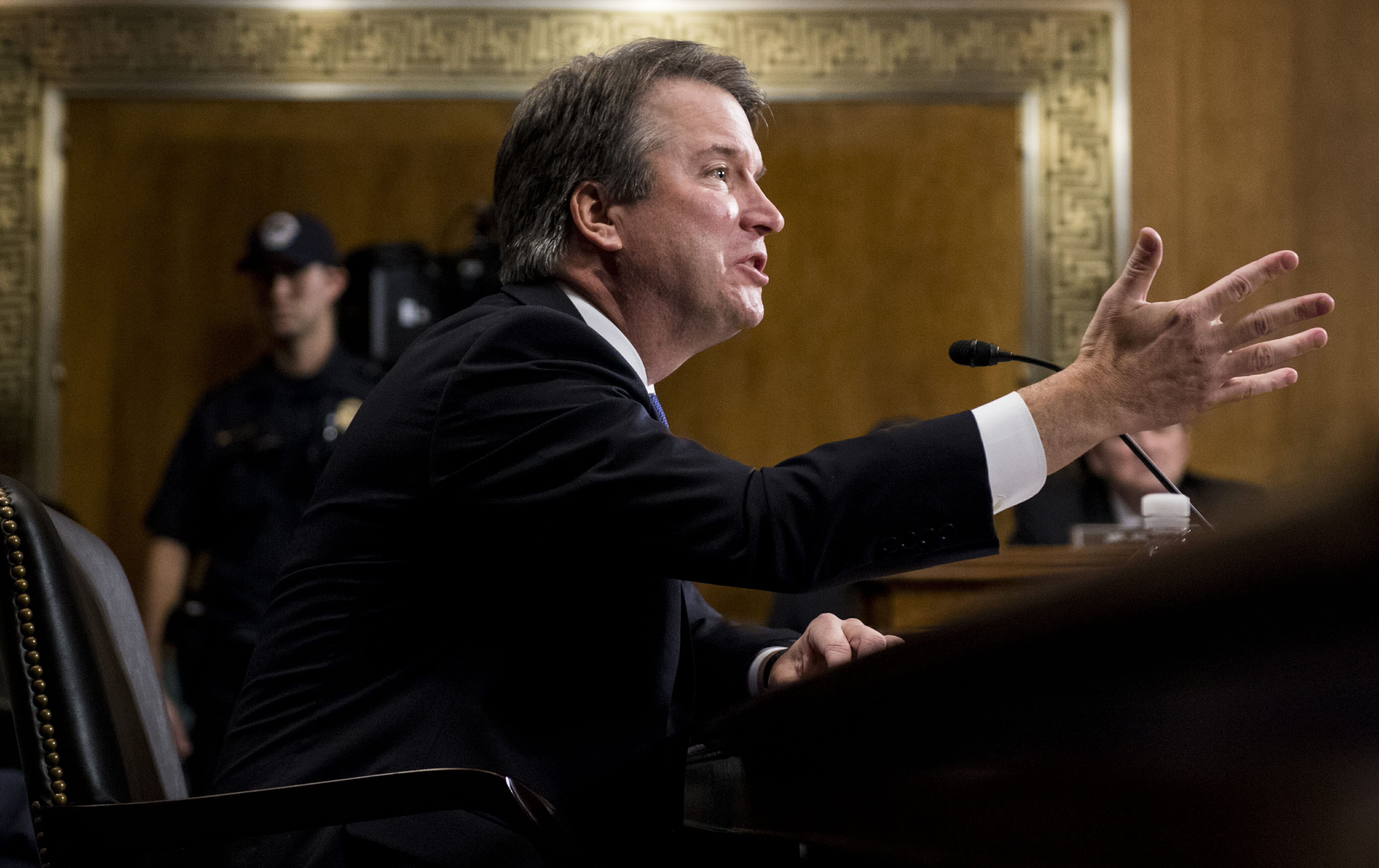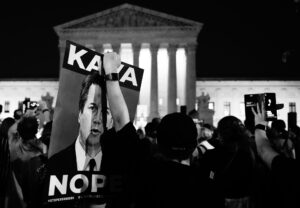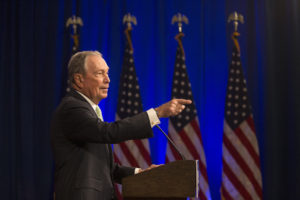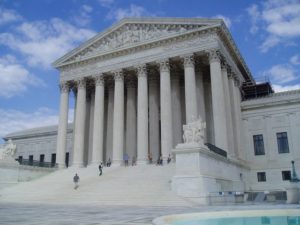Impeach Trump and Kavanaugh Both
The president’s abuse of power is on full display and the Supreme Court justice is implicated in perjury. Supreme Court nominee Judge Brett Kavanaugh testifies before the Senate Judiciary Committee in September 2018. (Tom Williams/Pool Image via AP)
Supreme Court nominee Judge Brett Kavanaugh testifies before the Senate Judiciary Committee in September 2018. (Tom Williams/Pool Image via AP)
It’s election season, and impeachment is in the air.
But it’s not just President Donald Trump who is the target of impeachment demands. Thanks to The New York Times, Supreme Court Justice Brett Kavanaugh is also hearing the “I” word for possible perjury committed during his raucous and controversial Senate confirmation hearings last year about his alleged sexual depredations as a teenager.
The Times triggered the Kavanaugh outcry Saturday, when it published an op-ed adapted from a new book, “The Education of Brett Kavanaugh: An Investigation,” written by reporters Robin Pogrebin and Kate Kelly, who helped cover the Kavanaugh hearings for the paper.
No one who watched the hearings on television will forget the gut-wrenching testimony of Dr. Christine Blasey Ford, who said Kavanaugh tried to rape her while drunk at a house party in high school. Nor will anyone forget Kavanaugh’s angry and tearful rebuttal, delivered under oath, denying Ford’s charges as well as those brought by Deborah Ramirez. A former classmate of Kavanaugh at Yale, Ramirez alleged that in their freshman year, Kavanaugh exposed himself and put his penis in her face during alcohol-infused dorm debauchery. (Unlike Ford, Ramirez was not invited to testify in person against Kavanaugh.)
The Ford and Ramirez stories have been covered before, but in their op-ed, Pogrebin and Kelly revealed a third—and never before disclosed—episode of drunken reveling and indecent exposure at Yale. They reported that another classmate, Max Stier, who is now the president and chief executive of the Washington, D.C.-based nonprofit Partnership for Public Service, notified senators and the FBI that he saw Kavanaugh drop his pants and push his penis into a coed’s hand. The FBI, however, declined to investigate, as did the Senate Judiciary Committee.
In an editorial correction published Monday morning, the Times revised the op-ed to clarify the “female student declined to be interviewed and friends say she does not recall the episode.” Both the original article and the revision also report that Stier has declined to discuss the incident publicly. Nonetheless, in both the original and revised versions, Pogrebin and Kelly claim they have “corroborated the story with two officials who have communicated with Mr. Stier.”
The Pogrebin/Kelly bombshell unleashed a tidal wave of Twitter outrage over the weekend from Democratic presidential candidates, including Kamala Harris, Beto O’Rourke, Elizabeth Warren and Julian Castro. Summing up the sentiment, Harris tweeted on Sunday that Kavanaugh “was put on the Court through a sham process and his place on the Court is an insult to the pursuit of truth and justice. He must be impeached.”
Kavanaugh, for his part, has wisely declined to comment on the op-ed or the calls for his impeachment. Trump, on the other hand, has proceeded with the usual reckless abandon.
Early Sunday morning, the commander-in-chief tweeted: “Brett Kavanaugh should start suing people for libel, or the Justice Department should come to his rescue. The lies being told about him are unbelievable. False Accusations without recrimination. When does it stop? They are trying to influence his opinions. Can’t let that happen!”
In the technical legal sense, the demands for the impeachment of Trump and Kavanaugh are separate and distinct. Impeachment, however, as I’ve written before, is a hybrid of law and politics. Politically, the demands are likely to prove mutually reinforcing, even as they are pursued individually.
Kavanaugh was nominated by Trump to replace the retiring Anthony Kennedy on the Supreme Court at the suggestion of the Federalist Society and other right-wing groups. He was confirmed by the Senate by the razor-thin margin of 50-48. He is widely perceived by those on the left as illegitimate, especially in light of the Senate’s snub of Merrick Garland, President Barrack Obama’s last nominee to the high tribunal.
Perjury, for which Kavanaugh is implicated, is clearly an impeachable offense. There have been 19 formal impeachments in U.S. history. Perjury and the making false statements figured prominently in the articles of impeachment adopted by the House in four of them, including the impeachment of Bill Clinton. Kavanaugh is at risk of becoming a fifth.
The best defense for Kavanaugh at this stage would be to let the scandal subside, and hope it eventually fades from the headlines. Unfortunately for him, unless Trump suddenly idles his Twitter feed, that’s not likely to happen. By urging Kavanaugh to “start suing people for libel” and suggesting the Justice Department “should come to his rescue,” Trump has all but guaranteed the exact opposite.
At the same time, Trump’s heavy-handed intervention on Kavanaugh’s behalf is an abuse of presidential power and an impeachable offense in its own right. Three of the 19 prior impeachments involved alleged abuses of power. The impeachment of Richard Nixon would have been a fourth, but Nixon resigned before the full House could vote on three articles of impeachment passed by the Judiciary Committee.
Will Trump’s name be added to the list? We’re still waiting for an answer from House Democrats.
Under the Constitution, the House holds the “sole power” of impeachment, which it can exercise by a simple majority vote in favor of a single article of impeachment. Although Democrats presently enjoy a large House majority with 235 members, Speaker Nancy Pelosi has refused to support Trump’s impeachment, fearing defeat in the Republican-controlled Senate, where a two-thirds vote is required to convict. Pelosi also sees a failed impeachment as bolstering Trump’s reelection prospects.
Still, the demands for Trump’s impeachment, and now Kavanaugh’s, will no doubt persist.
Last week, the House Judiciary Committee advanced the case against Trump, passing a resolution setting the rules that will govern its ongoing probe “to determine whether to recommend articles of impeachment” against Trump for “obstruction of justice, public corruption and other abuses of power.” The resolution authorizes Judiciary Chairman Jerrold Nadler, D-N.Y., to designate the full committee or a subcommittee to issue subpoenas and hold evidentiary hearings.
In form, the Nadler resolution is similar to the measure the Judiciary Committee endorsed on Oct. 30, 1973, to initiate its Nixon investigation. Over the next few months, support for Nixon’s impeachment increased. On Feb. 4, 1974, the full House voted 410-4 to authorize formal impeachment proceedings.
The rest, as they say, is a matter of record. On June 27, 1974, the Senate Watergate Committee issued its damning final report. On July 24, the Supreme Court ruled in United States v. Nixon that the president had to turn over secret Watergate-related audiotapes to Special Prosecutor Leon Jaworski. Three days later, the House Judiciary Committee passed its impeachment articles. On Aug. 9, Nixon resigned.
Of course, there are major differences between the past and the present, and it remains to be seen whether the impeachment remedy the Founding Fathers inserted in the Constitution still has any bite. In 1974, the Democratic Party had something resembling a spine, and a critical mass of Republicans still had a sense of shame and accountability. Not so today, sadly, not by a long shot.
Your support matters…Independent journalism is under threat and overshadowed by heavily funded mainstream media.
You can help level the playing field. Become a member.
Your tax-deductible contribution keeps us digging beneath the headlines to give you thought-provoking, investigative reporting and analysis that unearths what's really happening- without compromise.
Give today to support our courageous, independent journalists.






You need to be a supporter to comment.
There are currently no responses to this article.
Be the first to respond.